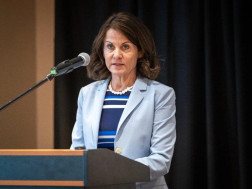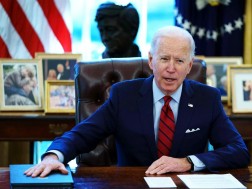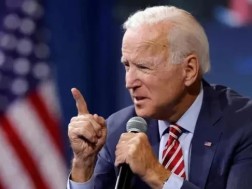One of the major goals of the Biden administration will be to stimulate the economy. New research suggests that one of the now-President’s campaign proposals could do just that, though it may need to overcome major hurdles to become a reality.
Biden’s plan to make community college free and four-year public college tuition-free for students from households earning $125,000 or less would increase Americans’ disposable income by $61 billion, according to an analysis published this week by the Campaign for Free College Tuition and Rise, an advocacy organization focused on college affordability and other youth and student issues.
The analysis, conducted by Robert Shapiro, a under-secretary of commerce during the Clinton administration, and Isaac Yoder, a senior analyst at Sonecon, Shapiro’s economic advisory firm, estimates that this extra $61 billion could boost GDP by $136 billion over 2021 and 2022.
The findings come as Biden begins his first week in office with a focus on combating the health and economic impacts of the pandemic. Biden’s free college campaign proposal didn’t make it into the stimulus plan he outlined last week, which is centered around more immediate concerns like speeding up vaccination distribution and re-opening K-12 schools.
But according to Shapiro, the free college proposal meets an often elusive goal for policymakers seeking to stimulate the economy: It could achieve an immediate economic boost and generate long-term benefits.
“This is a way to get stimulus for a fragile economy in a way that helps both in the short-term, millions of families, and creates a much more level playing field for millions of young people,” he said. “To me, this is a no brainer.”
Critics raise concerns about free college
To make Biden’s proposal a reality would require an act of Congress and it’s not without controversy. Critics have raised concerns about free college proposals in general and Biden’s in particular for a number of reasons, including that they would require state participation, which isn’t necessarily guaranteed, and the risk that a free college plan could give the federal government too large of a role in higher education policy.
Lawmakers would also have to agree to invest in free college. A bill introduced in 2017 by Senator Bernie Sanders, an independent of Vermont that is similar to Biden’s proposal would cost an estimated $600 billion over 10 years.
Shapiro and Yoder’s analysis found that Biden’s plan would provide an economic boost in multiple ways. The first is through that $61 billion of disposable income, essentially freeing up money some families would normally spend on college tuition to spend on other things.
Determining the so-called fiscal multiplier — or the increase to GDP generated by every $1 increase in government spending — is often one of the most controversial aspects of estimating the success of a government spending proposal.
In the study, the authors note that it can be challenging to estimate precisely.
To get a sense of how much additional spending by families getting rid of public-college tuition for many households would generate, Shapiro and Yoder looked at research on the economic impact of increases in Pell grants, the money the government provides low-income students to attend college, and adjusted the results to the specifics of Biden’s plan.
In addition to increasing some households’ disposable income, the plan could grow the economy by actually increasing the number of students who enter and complete college, the study found.
Based on a survey of available research on how students and families respond to additional support for college, adjusted for the particulars of Biden’s plan, the authors found that after a few years, the proposal would increase the number of students enrolled in college by 2 million annually.
In addition, the number of students graduating with associate’s degrees would grow by 776,000 or 42.7% and the number of students graduating with bachelor’s degrees would increase by 558,000 or 15.3%.
Each of those graduates would earn 16% and 67% more on average, for an associate’s and bachelor’s degree respectively, than if they had only graduated high school.
A proposal like Biden’s has the potential to fuel an uptick in college enrollment in a few key ways, Shapiro said. For one, making college free could actually eliminate a financial barrier for some to attending. In addition, even for those students from low-income households who already receive grants and scholarships generous enough to cover tuition, the complicated system of applying for and receiving financial aid may be deterring them from enrolling; a clear message that college would be free could fix that.
“Are we serious about providing something approaching equal opportunities for upward mobility because upward mobility requires a college degree,” Shapiro said. “Right now, we are clearly not doing that, it just jumps out of the data.”
Shapiro pointed to data cited in his analysis. For example, young white people ages 18 to 24 are 16% more likely to attend college than their Black peers and 18% more likely than young Hispanic people, Shapiro’s research notes.
What’s more, wealthier students are also more likely to attend and graduate college than their low-income peers. Among students from households in the bottom income quintile attending four-year colleges, 32% graduated with a bachelor’s degree, compared to 78% in the top income quintile, the research found.
Of course, boosting attendance at public colleges and universities could have consequences.
For one, Shapiro’s analysis anticipates that enrollment at nonprofit private colleges will decline by 270,000 as a result of Biden’s plan. In addition, public colleges likely don’t currently have the resources to cope with such a large uptick in students.
“State governments are going to have to reverse the recent trend which has been to reduce appropriations, which in turn have forced the universities to raise tuition,” he said. “That’s a vicious circle. We have to break out of that.”
“There are additional costs to this program, part of it may be some federal help for states to accommodate the increased demand,” he added.
Source: Marketwatch
















